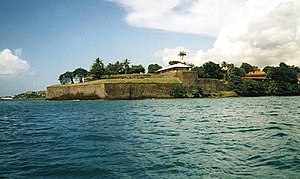Fort Saint Louis (Martinique)
This article needs additional citations for verification. (December 2008) |

Fort Saint Louis (often hyphenated as Fort Saint-Louis) is a seaside fortress in Fort-de-France, Martinique. The present-day fort has evolved from earlier strongholds that were erected on the site as early as 1638, and has been known in previous incarnations as Fort Royal and Fort de la Republique. The modern-day Fort Saint Louis is both an active naval base and a listed historic site of France. There are daily tours of the fort, though the portion that is still a naval base is off-limits.
Fort Saint Louis is under command of the
The active part of the fort includes the administrative buildings of the base, the service for naval constructions, the radio station of Pointe des Sables, ammunition storage facilities (at the end of Fort de France), and the Rivière Salée station (20 km away).
Environment
Fort Saint Louis has a commanding view of the anchorage of Fort-de-France, the island's capital city. It stands on a rocky peninsula at the edge of Fort-de-France Bay.
The fort has been home to many generations of a small but enduring colony of
History
In 1635, during the reign of
On 19 July 1674, during the
In 1677, Charles de La Roche-Courbon, comte de Blénac, became Governor-General, holding the post until 1683. He was responsible for the 10-year effort that resulted in the building of a 487-meter wall around the peninsula, the wall being four meters high and two meters thick. Comte de Blénac served as Governor-General again from June 1684 to February 1691, and again from 24 Nov 1691 until his death in 1696. His successor was the Marquis d'Amblimont, who had played an important role in the repulse of the Dutch.
In January 1759, the fort repulsed a British attack led by
On 11 February 1763, after the Treaty of Paris returned Martinique to French control, the British left and the fort resumed its name of Fort Royal. The French proceeded to construct a second fort, Fort Bourbon, on Morne Garnier to protect Fort Saint Louis.
In 1793, with the advent of the French Revolution, the fort's name was changed to Fort de la Republique.

In February 1794, the British
The Governor-General of Martinique at the time was Donatien Marie Joseph de Vimeur, comte de Rochambeau. The British occupied the fort from 22 May 1794 until September 1802 when the Treaty of Amiens again returned Martinique to France. The fort was renamed Fort Saint Louis.
The British captured Martinique again in 1809. During their attack, Commander
Admiral Louis Thomas Villaret de Joyeuse, who had become Governor-General in September 1802, was still in office at the time of the British attack. A Court of Inquiry in Paris in December 1809 stripped the Admiral and some of his subordinates of their rank and honors, holding them responsible for problems with the fortification of
Between 1850 and 1896, the French installed a number of artillery pieces at the fort and at Pointe des Negres to protect the bay.
References
- ^ "First Two EDA-S Next Gen Amphibious Landing Craft Delivered to French DGA". 25 November 2021.
- ^ Breuil, Michel (2000). "Taxon reports: i. delicatissima and i. iguana" (PDF). West Indian Iguana Specialist Group Newsletter. 3 (1). IUCN: 4–5. Retrieved 14 February 2012.[permanent dead link]
- ^ Napier (1862), p.17.
- Napier, Edward Delaval Hungerford Elers (1862) The life and correspondence of Admiral Sir Charles Napier, K.C.B., from personal recollections, letters, and official documents .... (London: Hurst and Blackett).
